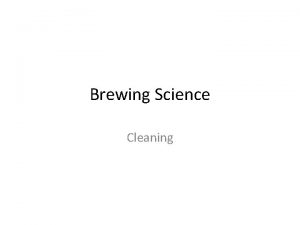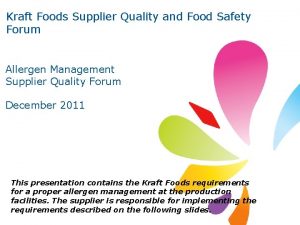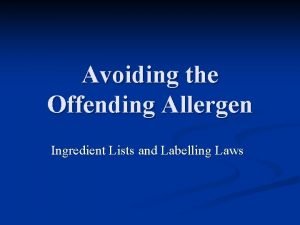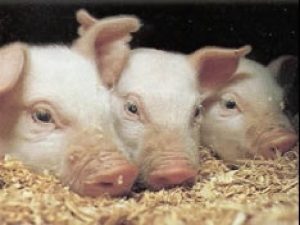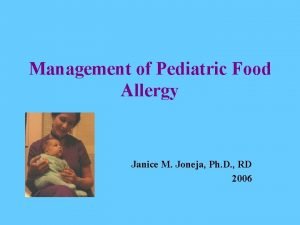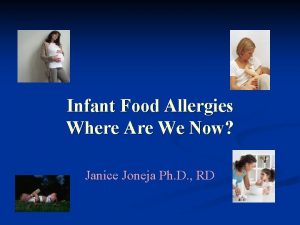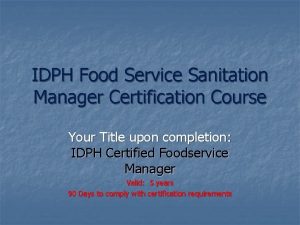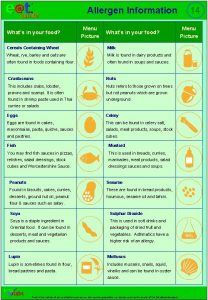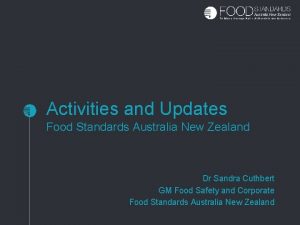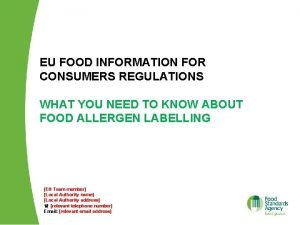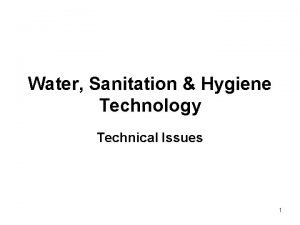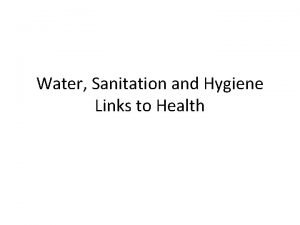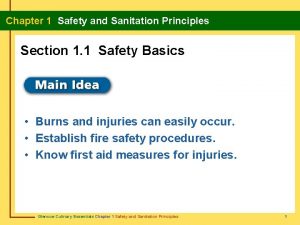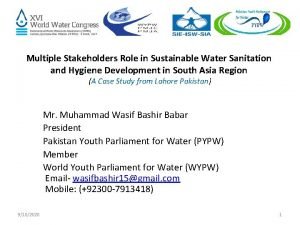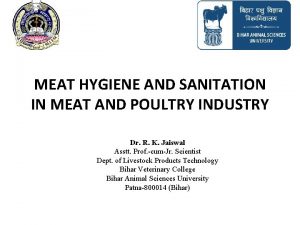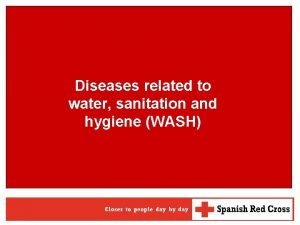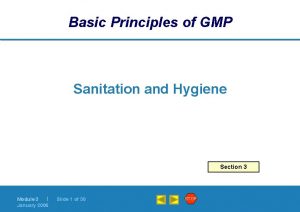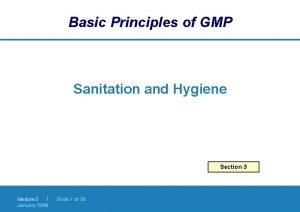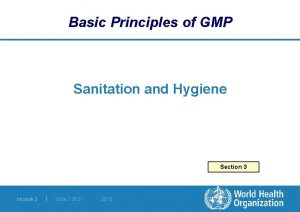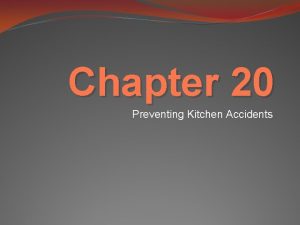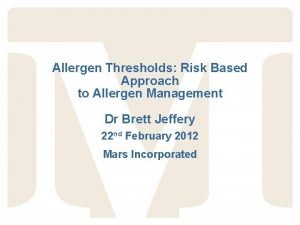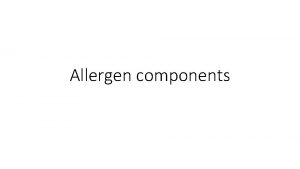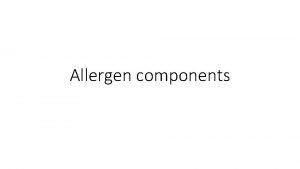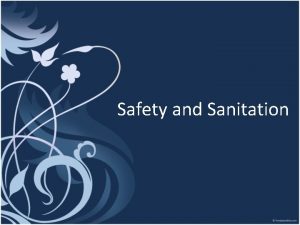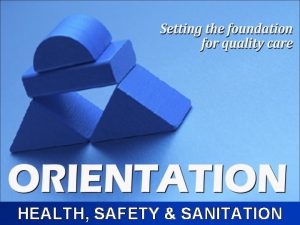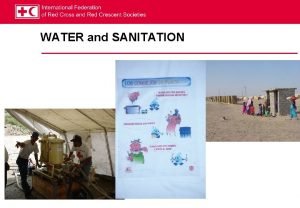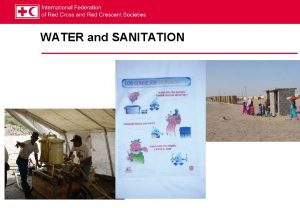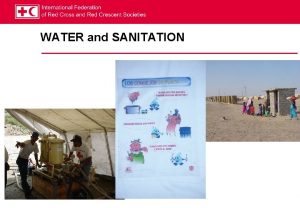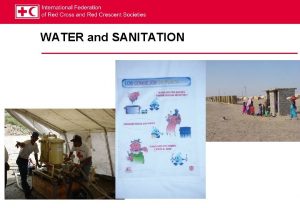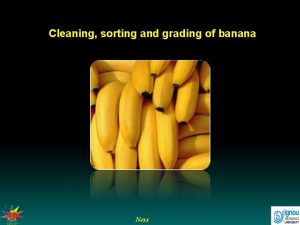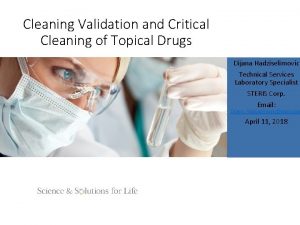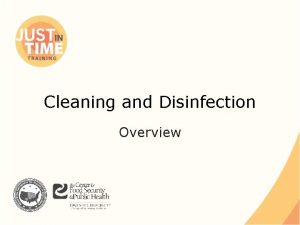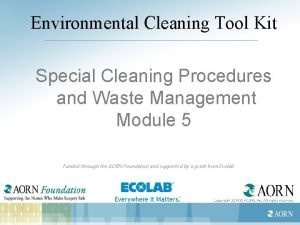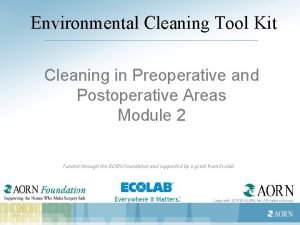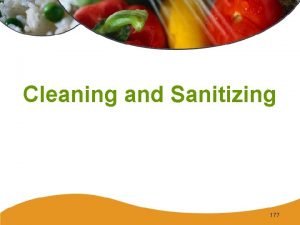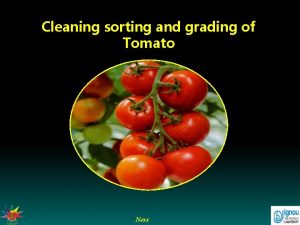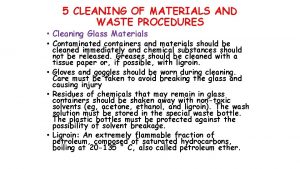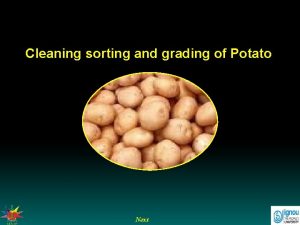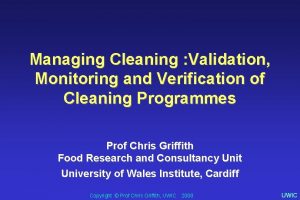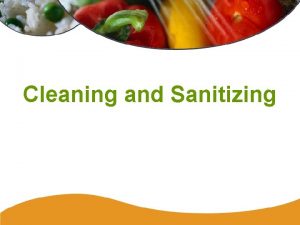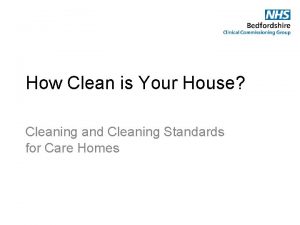Role of Cleaning and Sanitation at Preventing Allergen


























- Slides: 26

Role of Cleaning and Sanitation at Preventing Allergen Cross-contact Lauren S. Jackson, Ph. D. U. S. Food and Drug Administration Center for Food Safety & Applied Nutrition Office of Food Safety Division of Food Processing Science & Technology 6502 S. Archer Rd. Bedford Park, IL 60501 FSIS Public Meeting Preventing Undeclared Allergens March 16, 2017 Washington, DC

• Reportable Food Registry INTRODUCTION 2013 -2014 LM (19%) of total Salmonella (25%) • 30 -40% recalls in U. S. are due to undeclared allergens • Undeclared allergens increased from 30% of all reports in first Undeclared allergens in the fifth year, to 47% of(47%) reports • 5 -15% of allergen recalls are associated with consumer reactions 1 1 www. fda. gov from: Malyukova, Gendel, Luccioli. JACI 129(2): S 234, 2012 2

Allergen Recalls Causes of allergen recalls Cause of allergen recalls Number recalls Wrong package or label 153 Terminology 62 Failure to carry forward information from an ingredient to final label 45 Cross-contact 39 Ingredient mislabeled from supplier 38 www. fda. gov Most common foods categories involved in food allergen recalls Food Category Number recalls % Class I Bakery 153 62 Snack 62 62 Candy 45 63 Dairy 39 58 Dressing 38 59 From: Gendel et al. Food Safety April/May 2014 3

Allergen Cross-Contact • Unintentional incorporation of a food allergen into a food • Examples of causes – – – Dusts or aerosols created from allergens Cross-over points in processing lines Improper use of product rework Reuse of cooking/processing media Inadequate cleaning of shared food-contact surfaces • Possible preventive measures – Dedicated facility, line, cooking and processing media – Scheduling – Manufacturing and engineering controls – Properly manage rework – Use of an effective allergen cleaning procedure for shared equipment, utensils, etc. 4

Recall Likely Due to Cross-Contact/ Inadequate Cleaning www. fda. gov

Important Facts • • • Microbiologically clean is not equivalent to allergen clean Proteins are notoriously “sticky”- difficult to remove from food contact surfaces, especially if the protein has been heated Wet cleaning (use of detergents/water) can be effective at removing allergenic food soils- but all procedures should be evaluated for effectiveness Cleaning in a dry environment is a challenge— and it can be difficult to clean to “allergen clean” All methods for evaluating cleaning efficacy have shortcomings www. fda. gov

Factors Affecting Allergen Removal 1. Type of food allergen • • 2. Concentration of food allergen • 3. High vs. low concentration in food Type of food contact surface • • 4. Stainless steel, plastic, cloth Texture (finish) of surface How the allergen was applied to the surface • 5. 6. 7. 8. Physical form: Paste, particulate, powder, liquid Chemistry: Water- vs. lipid-based ingredients Hot vs. cold soil Equipment design Age of equipment Length of processing run Type of cleaning method 7

Cleaning Methods Wet – – Plant area designed to accommodate water Employ detergents and sanitizers Can be automated (CIP), semi-automated (COP), or manual Purging line with ingredient or next food* Dry – Plant area not designed to accommodate water – Water use limited – Compressed air, vacuum and/or dry steam may be used to “clean” surfaces – Other methods- blasting with CO 2 or food ingredients – Purging line with ingredient (e. g. salt) or next food* *Make sure that cross-contact issues do not occur 8

Effectiveness of Cleaning Solutions for Removing Protein Soils • Chlorinated Alkali Detergents -- Excellent • • • Alkali/Caustics with H 202 - Excellent Enzymes -- Excellent Alkali/Caustics -- Fair Very Good Detergent Builders/Surfactants -- Fair Very Good Acids -- Poor Water --- Poor to fair 9

Factors Affecting Allergen Removal- Wet Cleaning Action Time • Manual • Automated Soil (Containing Proteins) Chemical • Components • Concentration www. fda. gov TACT Clean Surface Temperature 10

What Do We Test? • CIP rinse-water • Push through materials (salt, sugar) • First product off line, final product • Food-contact surfaces (visual inspection; swabs)

Analytical Tools for Detecting Allergens/Allergenic Food Residue Least Specific • Visual Inspection • ATP Swabs • Total Protein • DNA-Based/PCR • Immunochemical • Mass spectrometry* Most Specific *Not used routinely for detecting allergens

Effectiveness of Cleaning Regimens for Removing Milk Residue from a Pilot-Scale HTST Processing Line Objectives: • Investigate the efficacy of different cleaning procedures (a water rinse, intermediate cleaning treatments, and a full cleaning cycle) on removal of milk proteins from a pilot-plant HTST system • Evaluate methods (conventional ATP, sensitive ATP, total protein and ELISA/Lateral flow) for verifying the effectiveness of procedures used to clean the HTST • Determine the levels of transfer (crosscontact) of milk residue from the cleaned HTST processing line to simulated apple juice 13

Procedures • Processed nonfat milk (38 L) o 81ºC for 17 sec o Re-circulate milk for 1 hour o Apply cleaning procedures (water rinse, intermediate cleaning procedures, and a complete cleaning cycle) • Evaluated efficacy of cleaning procedures o Swab ports (ATP, total protein, milkspecific LFD • Processed (38 L) “simulated apple juice” (single-pass) o Measured presence of milk in the simulated juice coming off line as a function of time and after pooled 14

Cleaning Procedures Water rinse Full-strength CAD a 15 min water flush at 81◦C with a flow rate of 55 -60 gal/h a 15 min water flush + a 60 min wash using full-strength CAD at 81◦C with a flow rate of 55 -60 gal/h Concentration a 15 min water flush + a 60 min with ¼-strength CAD of CAD Intermediate Cleaning time a 15 min water flush + a 15 min full-strength CAD cleaning Cleaning a 15 min water flush + a 60 min CAD at reduced regimens Temperature temperature (70◦C vs 81◦C) considered with different Cleaning flow a 15 min water flush + a 60 min full-strength CAD at lower rate flow rate (27. 7 gal/h vs 55 -60 gal/h) parameters Re-use CAD Full-clean cycle a 15 min water flush + a 60 min re-use CAD spiked with 1% milk a 15 min water flush, 60 min full-strength CAD at 81◦C, 30 min acid detergent at 70◦C, 15 min sodium hypochlorite sanitizer at room temperature at 55 -60 gal/h 15

LOW FLOW HIGH TEMPERATURE SHORT TIME (HTST) SYSTEM 16

Results: Cleaning studies of HTST processing line with a 15 min water rinse Swab Results of HTST Processing Line after Water Rinse Cleaning Sampling port location# Methods for detecting presence of milk residue Conventional ATPA Sensitive ATPB Total protein. C LFDD 1 3/3* 3/3 3/3 2 3/3 3/3 3/3 4 3/3 3/3 5 3/3 3/3 6 3/3 3/3 * 3/3 trials resulted in detection of milk residue, A: Pocketswab (Charm Sciences), B: Allergiene (Charm Sciences), C: Allertect (3 -M), D: Bioavid for milk (R-Biopharm) 17

Levels of Milk Cross-Contact into Simulated Apple Juice from an HTST Processing Line after Water Rinse (μg/m. L ) Sampling time Trial A Trial B Trial C Milk Concentration (ppm) 2 min 51. 1 49. 4 376 159± 188 4 min 40. 3 31. 1 180 83. 8± 83. 4 6 min 47. 3 29. 5 165 80. 6± 73. 8 10 min 45. 8 67. 9 113 62. 7± 44. 8 12 min 42. 8 28. 5 101 57. 5± 38. 5 composite sample 103. 8 58. 7 150 104± 45. 7 n. d. = not detected 18

Results: Cleaning of HTST processing line with a lower cleaning temperature (70ºC vs 81ºC) Swab Results of HTST Processing Line a 60 min Full-Strength CAD at 70ºC Sampling port location# Method for detecting presence/absence of milk residue Conventional ATPA Sensitive ATPB Total protein. C LFDD 1 1/3 3/3 2 1/3 3/3 3 1/3 3/3 2/3 3/3 4 1/3 3/3 5 3/3 2/3 3/3 6 1/3 3/3 19

Levels of Milk Cross-Contact into Simulated Apple Juice from an HTST Processing Line after a 60 min Full-Strength CAD at 70ºC (μg/m. L) Sampling time Trial. A Trial. B Trial. C Milk Concentration (ppm) 2 min 3. 87 38. 2 n. d 14. 0± 21. 0 4 min 3. 6 2. 6 n. d <LOQ 6 min 3. 53 n. d <LOQ 10 min n. d. 12 min n. d. composite sample 2. 7 5. 4 n. d 2. 70± 2. 70 n. d. = not detected 20

Results: Cleaning of HTST processing line with a full cleaning cycle Swab Results of HTST Processing Line after Full-Strength CAD Sampling port location# Method for detecting presence of milk residue Conventional ATPA Sensitive ATPB Total protein. C LFDD 1 0/3 1/3 0/3 2 0/3 1/3 0/3 1/3 0/3 4 0/3 1/3 0/3 5 0/3 2/3 0/3 6 0/3 1/3 0/3 No milk residue was detected in simulated juice processed over the line after a full clean cycle. 21

Methods for Cleaning in a Low Water Activity Environment • • Compressed air Grit/CO 2 blasting Premoistened (alcohol) wipes/cloths Vacuum “Dry steam” Brushing Purge with other dry ingredients A combination of dry cleaning methods

Use of Dry Steam to Clean Transfer Belting Procedure • Contaminated surface of urethane- • faced belt with peanut butter cookie dough containing peanut butter, egg and milk Cleaning variable • • Cleaning time (0 -20 min) Swabbed surface of belt and analyzed for ATP, total protein, ELISA (lateral flow); also assessed if surface was “visually clean”

Cleaning Time (min) Method for Detecting Presence of Food Soil Visual Conventional ATP Total Protein Lateral Flow Peanut Milk Egg 0 9/9 9/9 3/9 6/9 5 0/9 9/9 5/9 0/9 5/9 3/9 10 0/9 8/9 7/9 0/9 4/9 3/9 15 0/9 6/9 5/9 0/9 4/9 3/9 20 0/9 5/9 3/9 0/9 7/9 3/9

Conclusions § Cleaning is essential for preventing allergen cross-contact in facilities where equipment is shared § Allergenic foods/proteins vary in their ability to be cleaned from food-contact surfaces § Wet and dry cleaning methods are available for removing allergenic food soils; they vary in their effectiveness § Wet cleaning methods that use detergents which are capable of 1) reducing the interaction between the proteins and the foodcontact surface and 2) solubilizing proteins tend to be more effective at allergen removal § Cleaning to “allergen clean” in a dry environment can be challenging § It is recommended that all cleaning methods are evaluated for effectiveness § Development of food-contact surfaces and equipment designs that are more cleanable, particularly in dry food manufacture is needed 25

Questions?
 Cleaning and sanitation manual for breweries
Cleaning and sanitation manual for breweries Allergen checklist for food suppliers and manufacturers
Allergen checklist for food suppliers and manufacturers Avoid the offending allergen that
Avoid the offending allergen that Control ctrl allergen
Control ctrl allergen Joneja allergen chart
Joneja allergen chart Joneja allergen chart
Joneja allergen chart Idph allergen awareness
Idph allergen awareness Menu with allergen information
Menu with allergen information Plain english allergen labelling
Plain english allergen labelling Sfbb allergen chart
Sfbb allergen chart Chapter 24 lesson 2 preventing and treating stds
Chapter 24 lesson 2 preventing and treating stds Chapter 9 resolving conflicts and preventing violence
Chapter 9 resolving conflicts and preventing violence Chapter 14:1 using body mechanics
Chapter 14:1 using body mechanics Chapter 9 resolving conflicts and preventing violence
Chapter 9 resolving conflicts and preventing violence Chapter 13:2 preventing accidents and injuries
Chapter 13:2 preventing accidents and injuries Sanitation and hygiene
Sanitation and hygiene Sanitation and hygiene
Sanitation and hygiene Chapter 1 safety and sanitation principles
Chapter 1 safety and sanitation principles Stakeholders in water and sanitation
Stakeholders in water and sanitation Poultry hygiene and sanitation
Poultry hygiene and sanitation Sanitation and hygiene
Sanitation and hygiene Gmp sanitation and hygiene
Gmp sanitation and hygiene Gmp sanitation and hygiene
Gmp sanitation and hygiene Gmp sanitation and hygiene
Gmp sanitation and hygiene Compendium of sanitation systems and technologies
Compendium of sanitation systems and technologies C# azure worker role example
C# azure worker role example Chapter 20 preventing kitchen accidents
Chapter 20 preventing kitchen accidents
